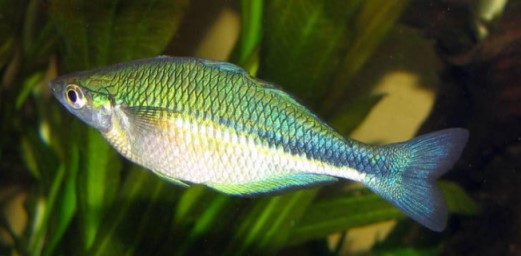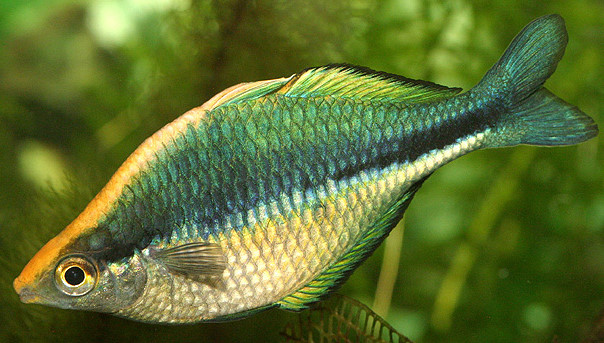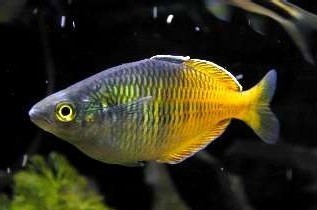| Colour
Changes in Rainbowfish Some rainbowfish of the genus Melanotaenia show a range of body colour changes that makes them very variable in colour. For example, an adult, male M. lacustris shows rapid changes in the iridescence on the body of a live fish, as the the chromatophores and iridiophores change appearance with the mood of the fish. The colour changes are located on the body, generally, or along a blaze located along the dorsal edge of the fish, from "forehead" to the dorsal fins. The Australian Museum fish site reports: "Many species of fishes however can change colour. The changes can be slow or fast. Slow changes of colour (eg breeding colouration) are generally under the control of hormones and are usually semi-permanent. Rapid colour changes (eg stress responses) are largely under control of the nervous system although hormones may also be involved. The colour of fishes can also vary with the seasons, between day and night and even with changes in habitat and food.
Iridiophores contain highly reflective guanine crystals. The crystals act as mirrors, which reflect the colours of the outside environment. Iridiophores are responsible for the silvery appearance of many pelagic fishes." (Source 1) They are also responsible for the iridescence in rainbowfish. The picture at left, of a young, male Melanotaenia lacustris, shows the iridescence given by its iridiophores on the sides of the fish and fins, most noticeably as silver on the underside and as an opaline play of yellow, green, turquoise, blue and violet colours on the upper body and fins. The dark blue stripe in the caudal end of the fish and the orange-red rows of dots between the scales are due to the chromatophores located there. This species changes colour very noticeably, depending upon mood, time of day and whether the fish is displaying for some reason.
It is this second colour change that I find fascinating, as the colour changes very rapidly in flashes. One commentator described the flashes in Melanotaenia lacustris in the following way: a "dominant or spawning male is a sight to behold and a true wonder of nature. His forehead turns a really bright orange in colour and then flashes various shades of blue, green, purple and violet. These colour changes may last up to about 1 second for each shade but continually change whilst the male is spawning which in turn can last for 30 minutes or more. These colours are almost as bright and attractive as a series of neon lights." [Source 2]
I have seen a similar flashing blaze in M. duboulayi but of a bright, golden-yellow colour. It is as though the fish turns on this iridescence in response to another fish (or me observing above him) as a threat or warning signal. M. maccullochi (Harvey Creek) shows a vivid red-orange flashing blaze of true neon appearance and M. splendens displays in orange-yellow. In the cases observed in M. boesemani, M. lacustris and M. splendens, the colour flashes were seen on occasions when a dominant male was defending territory, showing aggression or displaying to a female. It appears to be a remarkable adaptation for display that is more highly developed (or visible) in some species of rainbow. It would be interesting to test whether other species of rainbowfish exhibit a similar flashing colour blaze and under what circumstances or stimulus. |
|
Link to Notes of Keeping New Guinea Rainbows Link to Notes on Keeping Australasian Blue-eyes- fishes also related to the the Rainbows. Breeding and Raising Rainbowfish Fry
GOOD LUCK WITH YOUR RAINBOWS
|
 There are two kinds of cells that give
colour to fishes, chromatophores and iridiophores (also called
iridocytes). The Chromatophores are located in the dermis of the
skin, above or below the scales. They
impart true colour (rather than
There are two kinds of cells that give
colour to fishes, chromatophores and iridiophores (also called
iridocytes). The Chromatophores are located in the dermis of the
skin, above or below the scales. They
impart true colour (rather than
 Two types of colour change are notable. The first being
in the general
ability to change body colour, stripes and patches, and the second being the
ability to change the colour of a specific colour blaze that runs
along the top of the body from the forehead to the dorsal fins. The
colour blaze is shown clearly in the photograph, at right. The black
chromatophores are also more prominent in that individual.
Two types of colour change are notable. The first being
in the general
ability to change body colour, stripes and patches, and the second being the
ability to change the colour of a specific colour blaze that runs
along the top of the body from the forehead to the dorsal fins. The
colour blaze is shown clearly in the photograph, at right. The black
chromatophores are also more prominent in that individual. In M. boesemani there is a
similar, bright, iridescent, green stripe or blaze running from the mouth, along the
top of the head and back to the second dorsal fin. The
picture, at left, clearly shows a pale, blue colour along the head
of M. boesemani but does not
capture the iridescence well. When
viewed from above, this stripe is bright and very prominent.
However, it is not
always present. It comes and goes, brightens and flashes, with the
mood of the fish. It varies in colour, too, from iridescent green to
nearly white.
In M. boesemani there is a
similar, bright, iridescent, green stripe or blaze running from the mouth, along the
top of the head and back to the second dorsal fin. The
picture, at left, clearly shows a pale, blue colour along the head
of M. boesemani but does not
capture the iridescence well. When
viewed from above, this stripe is bright and very prominent.
However, it is not
always present. It comes and goes, brightens and flashes, with the
mood of the fish. It varies in colour, too, from iridescent green to
nearly white.